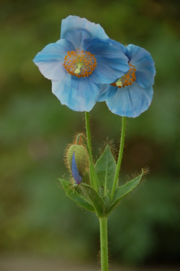Meconopsis: Difference between revisions
New page: __NOTOC__{{Plantbox | name = ''Meconopsis'' | common_names = <!--- if multiple, list all, if none, leave blank --> | growth_habit = ? <!--- tree, shrub, herbaceous, vine, etc --> | h... |
No edit summary |
||
| Line 1: | Line 1: | ||
{{SPlantbox | |||
|genus=Meconopsis | |||
|Min ht metric=cm | |||
|Temp Metric=°F | |||
|jumpin=This is the plant information box - for information on light; water; zones; height; etc. If it is mostly empty you can help grow this page by clicking on the edit tab and filling in the blanks! | |||
|image=Upload.png | |||
|image_width=240 | |||
}} | |||
{{Inc| | |||
Meconopsis (Greek, poppy-like). Papaveraceae. Poppy-like herbs, annual and perennial, useful as garden flower plants. | |||
Simple or rarely much-branched plants with yellow juice, annual or biennial (monocarpic: seeding but once) or perennial, with showy large yellow, reddish or blue fls. in cymose racemes or panicles or borne singly: lvs. stalked when radical, short-stalked or sessile when cauline, entire, lobed, or dissected: sepals 2, usually deciduous; petals 4, varying to 5-10: stamens many; stigmas forming a globular mass or body on the several- to many-carpelled ovary: caps, oblong to clavate or even cylindrical, 1-celled with 4 or more projecting placentae, opening by short teeth or valves at the summit.—Species 28 as defined by Fedde (Das Pflanzenreich, hft. 40. 1909), in the northern extra-tropical regions, mostly in Asia, 2 in W. N. Amer.; other species have been described subsequently. In 1906, Prain admitted 27 species (Ann. Bot. XX, pp. 323-365). | |||
The species of Meconopsis have recently come into much prominence, mostly as herbaceous perennial subjects for borders and rock-gardens. Heretofore these plants have been known mostly by M. cambrica and M. heterophylla, but within ten or twelve years many attractive species have been introduced from the high elevations in the China-Tibet region. It is probable that the genus will have a great extension of popularity among gardeners. Hybrids already have appeared. Coming from high altitudes, they may be treated as hardy plants. They propagate readily from seed sown directly in the open in spring, or they may be started under glass and transplanted. The annual-biennial species may be carried as seedlings in pots the first summer and planted out in autumn if it is desired to bloom them the second year. They require partial shade. The Chinese and Himalayan species are essentially alpines, and it is probable that they would not withstand the American summers without very special treatment. Their availability here is yet to be determined. | |||
}} | |||
__NOTOC__{{Plantbox | __NOTOC__{{Plantbox | ||
| name = ''Meconopsis'' | | name = ''Meconopsis'' | ||
Revision as of 15:51, 4 January 2010
| Meconopsis subsp. var. | ||||||||||||||||||||||||||||||||||||||||||||||||||||||||
|---|---|---|---|---|---|---|---|---|---|---|---|---|---|---|---|---|---|---|---|---|---|---|---|---|---|---|---|---|---|---|---|---|---|---|---|---|---|---|---|---|---|---|---|---|---|---|---|---|---|---|---|---|---|---|---|---|

|
|
| ||||||||||||||||||||||||||||||||||||||||||||||||||||||
| ||||||||||||||||||||||||||||||||||||||||||||||||||||||||
| Standard Cyclopedia of Horticulture |
|---|
|
Meconopsis (Greek, poppy-like). Papaveraceae. Poppy-like herbs, annual and perennial, useful as garden flower plants. Simple or rarely much-branched plants with yellow juice, annual or biennial (monocarpic: seeding but once) or perennial, with showy large yellow, reddish or blue fls. in cymose racemes or panicles or borne singly: lvs. stalked when radical, short-stalked or sessile when cauline, entire, lobed, or dissected: sepals 2, usually deciduous; petals 4, varying to 5-10: stamens many; stigmas forming a globular mass or body on the several- to many-carpelled ovary: caps, oblong to clavate or even cylindrical, 1-celled with 4 or more projecting placentae, opening by short teeth or valves at the summit.—Species 28 as defined by Fedde (Das Pflanzenreich, hft. 40. 1909), in the northern extra-tropical regions, mostly in Asia, 2 in W. N. Amer.; other species have been described subsequently. In 1906, Prain admitted 27 species (Ann. Bot. XX, pp. 323-365). The species of Meconopsis have recently come into much prominence, mostly as herbaceous perennial subjects for borders and rock-gardens. Heretofore these plants have been known mostly by M. cambrica and M. heterophylla, but within ten or twelve years many attractive species have been introduced from the high elevations in the China-Tibet region. It is probable that the genus will have a great extension of popularity among gardeners. Hybrids already have appeared. Coming from high altitudes, they may be treated as hardy plants. They propagate readily from seed sown directly in the open in spring, or they may be started under glass and transplanted. The annual-biennial species may be carried as seedlings in pots the first summer and planted out in autumn if it is desired to bloom them the second year. They require partial shade. The Chinese and Himalayan species are essentially alpines, and it is probable that they would not withstand the American summers without very special treatment. Their availability here is yet to be determined.
|
Meconopsis {{{latin_name}}}
|
'
| ||||||||||||||||||||||||||||||||||||||||
|---|---|---|---|---|---|---|---|---|---|---|---|---|---|---|---|---|---|---|---|---|---|---|---|---|---|---|---|---|---|---|---|---|---|---|---|---|---|---|---|---|---|

|
|
| |||||||||||||||||||||||||||||||||||||||
| |||||||||||||||||||||||||||||||||||||||||
- Do you have a description of this genus or plant? Edit this section!
Cultivation
- Do you have cultivation info on this plant? Edit this section!
Propagation
- Do you have propagation info on this plant? Edit this section!
Pests and diseases
- Do you have pest and disease info on this plant? Edit this section!
Species
Includingwp:
M. aculeata
M. betonicifolia (Himalayan blue poppy)
M. cambrica (Welsh poppy)
M. chelidonifolia
M. grandis
M. lancifolia
M. napaulensis (Nepal poppy)
M. punicia
M. quituplinerva
M. simplicifolia (blue poppy)
Gallery
If you have a photo of this plant, please upload it! Plus, there may be other photos available for you to add.
-
photo 1
-
photo 2
-
photo 3
References
External links
- Meconopsis.org specialized website - includes further links
- w:Meconopsis. Some of the material on this page may be from Wikipedia, under the Creative Commons license.
- Meconopsis QR Code (Size 50, 100, 200, 500)
